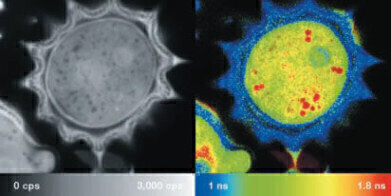Microscopy & Microtechniques
Highly Flexible FLIM and FCS Analyses
Jun 17 2009
Olympus has announced that its FluoView FV1000 confocal laserscanning microscope (cLSM) and FV1000MPE Multiphoton ranges can now be fitted with the PicoQuant module for Fluorescence Lifetime Imaging (FLIM) and Fluorescence Correlation Spectroscopy (FCS). FLIM and FCS are advanced methods for measuring minute changes in fluorescence that occur in cells over very short periods of time.
The addition of FLIM and FCS capabilities further increases the versatility of the Olympus FluoView FV1000 cLSM and ensures that users can bring a new dimension to their research.
The new PicoQuant module available from Olympus enables advanced FLIM and FCS, and is based on time-correlated single photon counting (TCSPC) using time-tagged time-resolved (TTTR) data handling. This is considered to be the most precise technique with the highest temporal resolution. The unique pulsed diode lasers provide picosecond or femtosecond pulses at high repetition rates from 375 nm – 900 nm with controllable power and pulse frequency. The multichannel version can also perform pulsed interleaved excitation (PIE), and up to four pulsed laser units can be combined into one optical fibre via a coupling unit, making wavelength changes or simultaneous excitation schemes very easy.
The TCSPC data acquisition unit has a very high temporal resolution of 4 ps. Data acquisition is done in the unique TTTR mode in which the temporal information of each detected photon is preserved, which allows very sophisticated offline analyses. Two different detector technologies are available in either single- or dual-channels, providing greater system flexibility. Photon-multiplier tubes (PMTs) offer excellent properties for FLIM techniques, whereas the higher detection efficiency of single-photon avalanche diodes (SPADs) makes them ideal for FCS. Furthermore, for measurements that require high detection efficiencies, two types of SPADs are available. These detectors ensure the system has the versatility to resolve fluorescence lifetimes well below 100 picoseconds and perform ‘online FLIM’ depending on the setup in use. All the components of the PicoQuant module are controlled via the SymPho Time software. The software also supports a number other related procedures including fluorescence lifetime correlation spectroscopy (FLCS), fluorescence resonance energy transfer (FRET) and PIE-FRET.
Digital Edition
Lab Asia 31.2 April 2024
April 2024
In This Edition Chromatography Articles - Approaches to troubleshooting an SPE method for the analysis of oligonucleotides (pt i) - High-precision liquid flow processes demand full fluidic c...
View all digital editions
Events
May 14 2024 Oklahoma City, OK, USA
May 15 2024 Birmingham, UK
May 21 2024 Lagos, Nigeria
May 22 2024 Basel, Switzerland
Scientific Laboratory Show & Conference 2024
May 22 2024 Nottingham, UK












.jpg)





